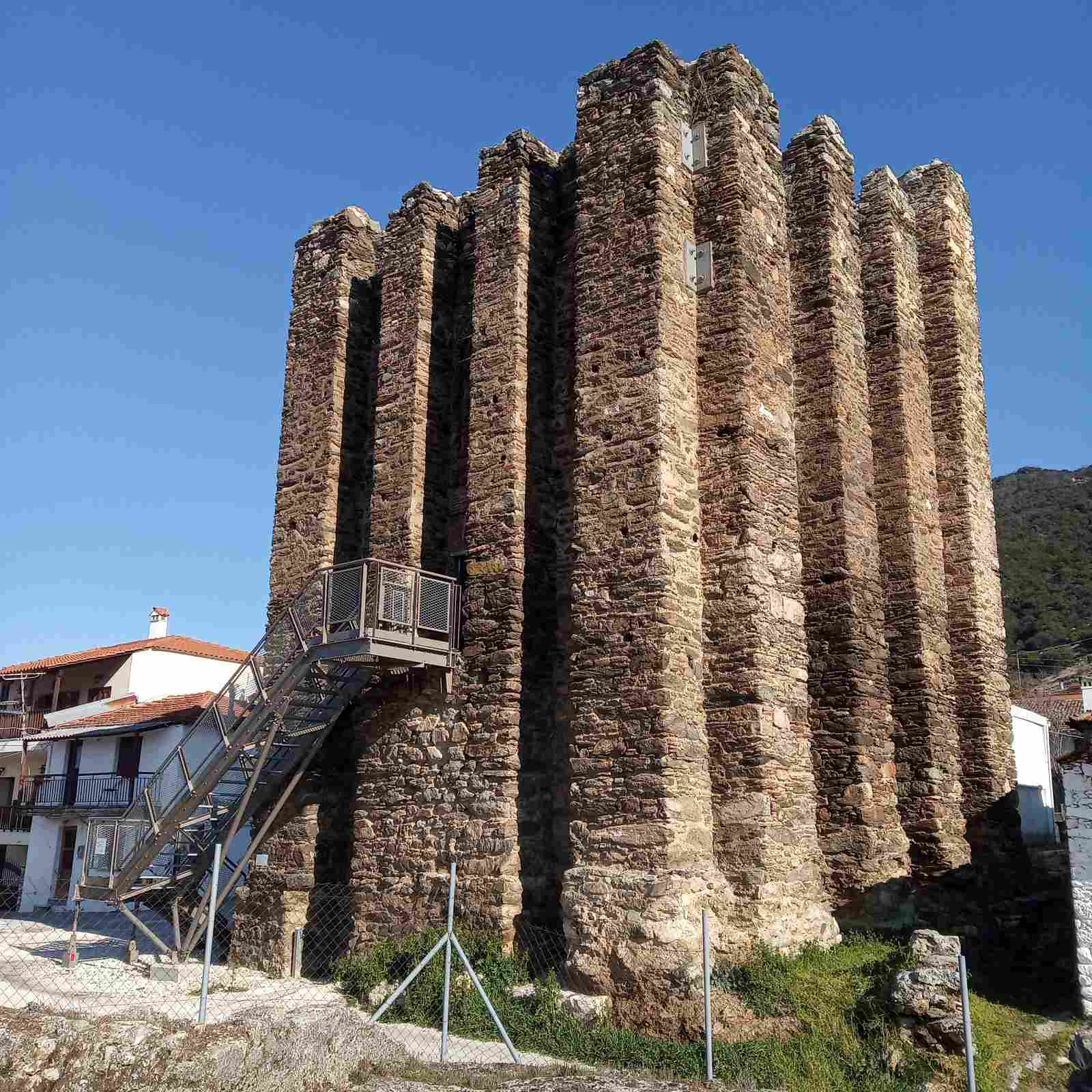
The Byzantine tower, a fortified building with strong pillars that support the external walls, is located in the center of Galatista. Nowadays, it is preserved at a height of about 16m with three levels in the interior. Archaeological work that was carried out on the monument led to its dating in the 11th and 14th centuries, and it acquired its current form following its renovation and restoration. A water mill, the church of St. Paraskevi, an olive press (ladario) and a distillery (rakario) are directly related to the tower and testify to the agricultural and production activities in Galatista. The Galatista Tower hosts the exhibition “The towers of Chalkidiki” since 2014.
Galatista is an important old settlement of mountainous Chalkidiki, located forty kilometers east of Thessaloniki, on the old road leading to Ierissos and Mount Athos. The Byzantine tower, for which unfortunately we have no evidence from written texts, is associated with the region. It is one of the best preserved towers of Chalkidiki, which stands as an exemplar of both fortification and residential architecture. A medieval settlement recorded under the name Galatissa developed around this tower. Apparently, it was a significant settlement, since the name assigned to the main public road from “Thessaloniki to Galatissa” is derived by the settlement.
In terms of its architecture, the tower of Galatista forms part of a large group of quadrilateral Byzantine towers, common in Macedonia and Mount Athos. The characteristic architectural features, distinctly similar to edifices of the 11th to the 16th century, are the strong pillars that support the external walls. The tower is preserved to a height of about 16m, its external dimensions are 10x12m and it covers an area of approximately 90 sqm. Its walls are made of rough stones, and are 1.50 m thick. The entrance to the tower is elevated above ground level, as is often the case with medieval towers. Inside the lower blind floor, a built water tank plastered with hydraulic mortar was discovered. At the entrance level of the tower, at the north end of the west wall, there is a niche which probably served as a wash basin. A small latrine is set within the north wall of the first level. A type of kitchen (?) is located within the north wall of the second level. Lastly, in the north-east corner of the third level, the presence of a large niche in the north wall is detected, which can possibly be interpreted as a chapel with side niches.
The first conservation works on the dilapidated, roofless tower was carried out by the Archaeological Service in 1965. Several years later, in 1994, an excavation was carried out and the finds, such as numerous vessels intended for everyday use, coins, a bronze ring and several arrowheads, date back to the 11th up to the 14th century. Following its restoration and conservation, the tower was housed with a new three-pitched roof (internally perched, externally hidden), and the wooden floors in the interior, a new external staircase and the entrance door were reconstructed.
Based on research excavation carried out inside the tower, as well as its architectural form, it seems that the monument was constructed in two phases. The lower part belongs to the first phase of construction and dates back to the 11th century, while the upper part belongs to the second phase and dates back to the 14th century.
To the immediate south of the tower, on the steep downhill slope, a watermill survives which is also restored. It was part of a larger group of mills in a row, all of which operated with the same water; it dates back to the 19th century, but it keeps remnants and traces of past building phases intact. The water mill is part of a small preserved complex with a distinct character relating to agricultural and production activities, since, in addition to the church of St. Paraskevi, there is an olive press (ladario) and a distillery (rakario).
The Galatista Tower hosts the exhibition “The towers of Chalkidiki” since 2014, which focuses on the presence of towers as architectural landmarks in the countryside of Chalkidiki, their role in the agricultural production process and the actions undertaken by a Byzantine person in and around them.
Olga Iasonidou, Vangelis Maladakis
References
Theocharidis, Pl. L., “Observations on the Byzantine Buttressed Towers of Macedonia”, στο R. Scott, J. Burke (eds.), Byzantine Macedonia: Art, Architecture, Music and Hagiography, Melbourne 2001, 20-27
Θεοχαρίδης, Πλ., Παπάγγελος, Ι. Α., «Ο πύργος της Γαλάτιστας, Χαλκιδική, Ελλάς», στο Sl. Ćurčić, Ε. Χατζητρύφωνος (επιμ.), Κοσμική Μεσαιωνική Αρχιτεκτονική στα Βαλκάνια, 1300-1500, και η διατήρησή της, κατάλογος έκθεσης, Θεσσαλονίκη 1997, 222-223.
Ιασονίδου, Ό., Μαλαδάκης, Β., «Ο βυζαντινός πύργος της Γαλάτιστας ως μουσείο του εαυτού του. Ζητήματα πολιτιστικής διαχείρισης στην ελληνική περιφέρεια», στο Πρακτικά επιστημονικής ημερίδας προς τιμήν του αρχαιολόγου Ιωακείμ Αθ. Παπάγγελου, εκδ. ΟΔΑΠ (υπό εκτύπωση).
Χειμερινό:
Κλειστά - 1η Νοεμβρίου έως 31 Μαρτίου
Θερινό:
08:30-15:30 1η Απριλίου έως 31 Οκτωβρίου
Κλειστά Τρίτη
Είσοδος ελεύθερη
Address: Konstantinoupoleos 5,
631 00 Polygyros Halkidiki
Phone: +30 23710 22060
Fax: +30 2310 251892
Mount Athos Technical Office
Address: 7 Hippodrome Square, Thessaloniki
Phone: +30 2310 285163
Fax: +30 2310 251892
E-mail: [email protected]
